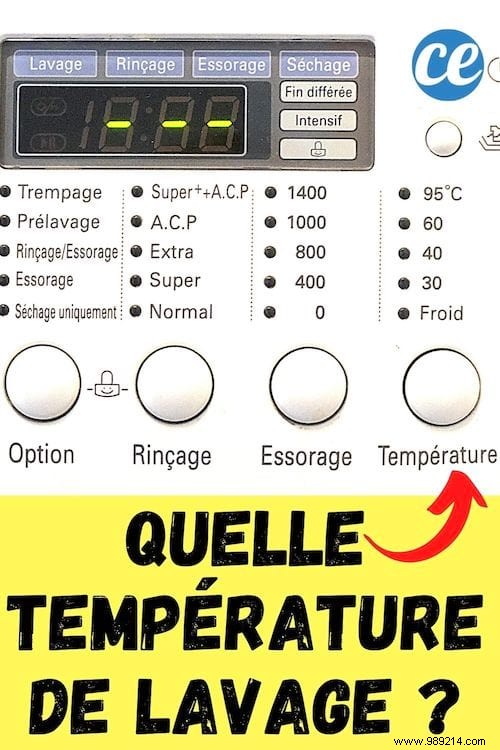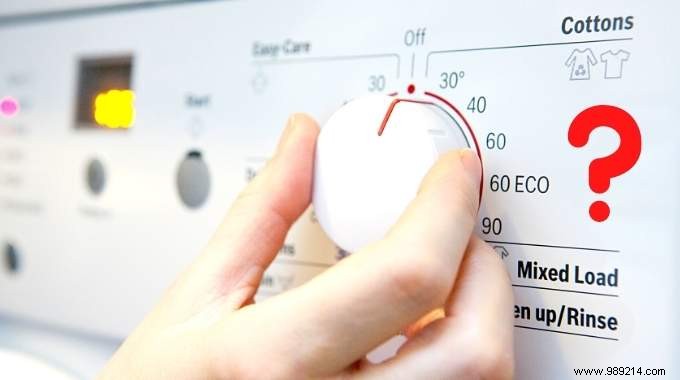
Today, we will see together what is the ideal temperature for washing his laundry.
This is an important question, because a large part of the electricity used by a washing machine is used to heat the water.
And you can imagine...
The hotter the water, the more electricity is consumed.
But the chosen program temperature does not only depend on electricity consumption.
It is also necessary to take into account the linen to be washed and its degree of soiling.
To see more clearly, a small point is welcome, isn't it?
Here is the easy guide to know at what temperature to wash your laundry . Watch:
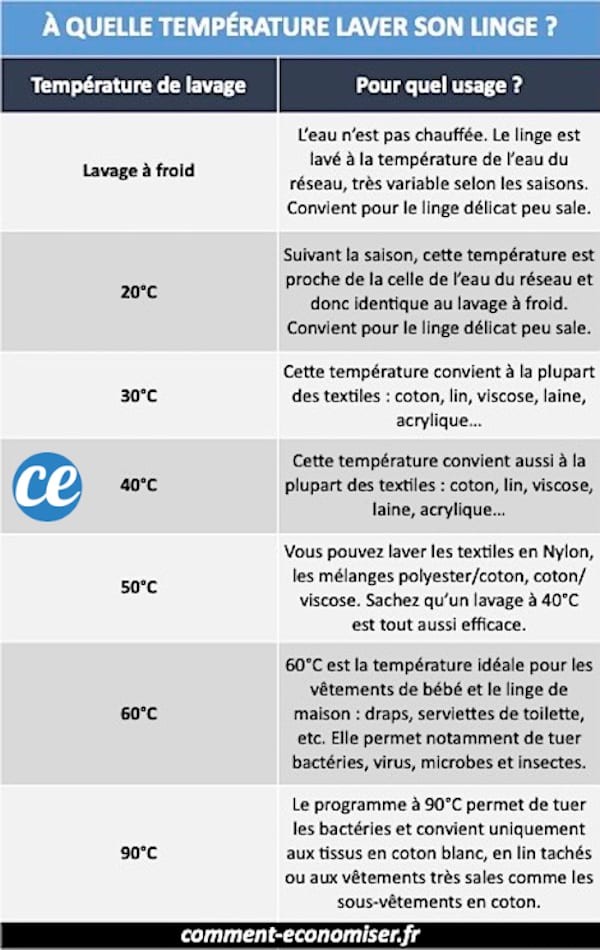
Click here to print this table in PDF format.
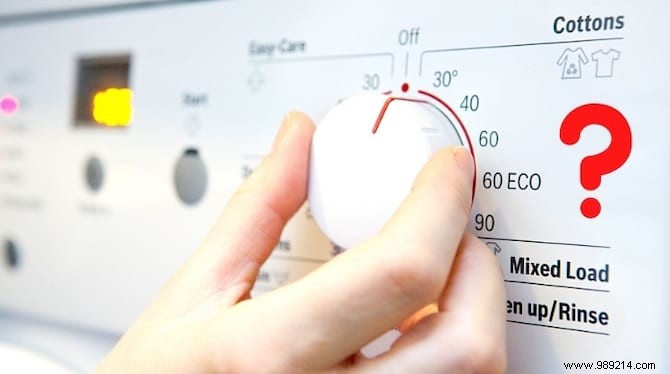
Cold wash: the water is not heated. The linen is washed at the temperature of the mains water, which varies greatly depending on the season. Suitable for lightly soiled delicate laundry.
Wash at 20°C: depending on the season, this temperature is close to that of mains water and therefore identical to cold washing. Suitable for lightly soiled delicate laundry.
Wash at 30°C: this temperature is suitable for most textiles:cotton, linen, viscose, wool, acrylic, etc.
Wash at 40°C: this temperature is also suitable for most textiles:cotton, linen, viscose, wool, acrylic...
Wash at 50°C: you can wash Nylon textiles, polyester/cotton blends, cotton/viscose. Note that washing at 40°C is just as effective.
Wash at 60°C: this is the ideal temperature for baby clothes and linens:sheets, towels, etc. In particular, it kills bacteria, viruses, microbes and insects.
Machine wash at 90°C: the 90°C program kills bacteria and is only suitable for stained white cotton, linen or heavily soiled items such as cotton underwear.
Note that these tips are valid for all washing machines, whatever their brand:Vedette, Whirlpool, Indesit, Haier, Brandt, Bosch, Faure, Electrolux...
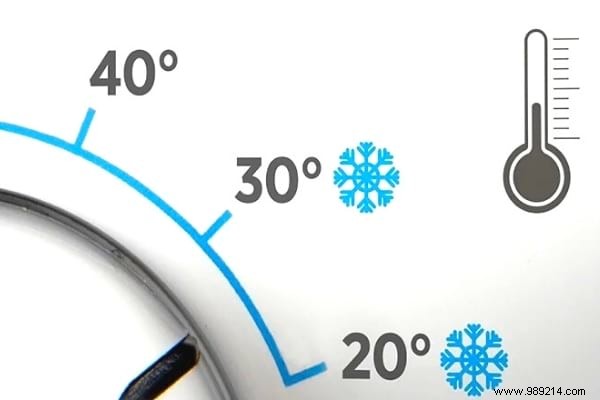
For lightly soiled and delicate laundry , a cold wash is necessary.
In this case, the water is not heated. It is therefore at the temperature of the water in your distribution network.
Depending on the season and the place of residence, the temperature can therefore vary a lot.
Just open a tap to realize it.
But in any case, this cold wash is suitable for fragile and delicate laundry (silk, wool, lace).
It is for this reason that it is necessary to check the washing label of your garment.
It is also suitable for lightly soiled laundry.
This cold wash is often symbolized by a snowflake on your washing machine's programmer.
It tends to compete with washing at 20°C.
It is also offered less and less often on washing machine programs.
It must be said that very often it is the temperature of the mains water, especially in summer.
So most of the time, washing cold and washing at 20°C are the same thing!
But one thing is certain.
This is obviously the most economical mode. Why?
Because the majority of the electricity used during a wash cycle is used to heat the water.
Do you see where I'm coming from?
The more you wash your laundry at a low temperature, the more you save electricity.
Another advantage. Washing at low temperature preserves the fibers of the fabric and the brilliance of the colors.
And that's not all. Because most detergents are now effective "even at low temperatures".
Take a good look at the recommendations for your detergent and check that it is suitable for cold washing.
But it's worth thinking about, isn't it?
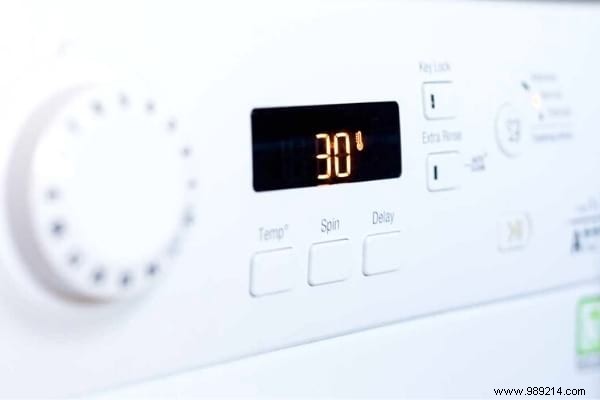
The vast majority of textiles can be washed with a program at 30°C.
It has the advantage of cleaning well and not being too hot either.
It therefore respects the fibers of the linen and the colors.
It is ideal for cotton, linen, viscose, wool or acrylic laundry.
Why wash your clothes at 30° C?
This program is very well suited for colored or black clothes.
As its temperature is low, the colors hold up better in the wash.
With a program at 30°C, you avoid the delicate problem of shrinking laundry.
It will not shorten the cotton fibers of your clothes.
As a result, you don't risk ending up with a sweater or a t-shirt that has become too small!
In addition, synthetic fibers are less wrinkled.
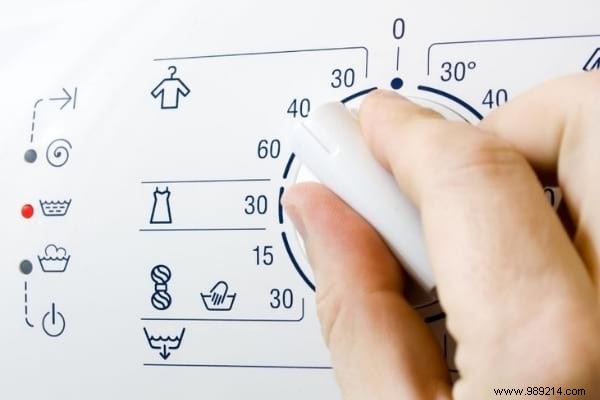
As a result, you are probably wondering what is the 40° program for? C?
This program is also suitable for garments made of cotton, linen, viscose, wool or acrylic .
But be aware that it is still much more effective against stains than the 30° programme C.
No wonder since the hotter the water, the less stains resist!
This is particularly true for grease or oil stains.
Hot water loosens dirt better and removes encrusted grease more easily. It is simply more effective than cold water.
Like when you do the dishes! Doing the dishes in hot water degreases and cleans better than doing them in cold water.
A program at 40°C is therefore more suitable for non-delicate and dirty laundry.
And the 50° program Cso?
This program is well suited to cotton garments such as t-shirts, jeans, nylon garments, or polyester/cotton or cotton/viscose blends.
But the 50°C program tends to disappear on washing machines.
Indeed, these are always more efficient.
And programs at 40°C are just as effective and much more economical.
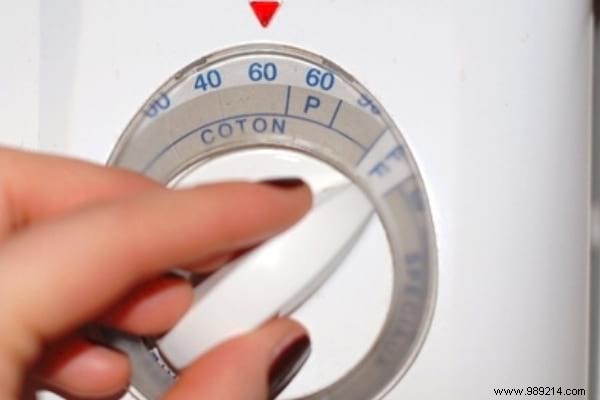
- A 60° program It is particularly well suited to baby clothes: pajamas, bibs, bodysuits...
You have probably noticed...
The little bits tend to get a lot dirty and make a multitude of stains :pee or poo stains, mashed potatoes or compote or fruit stains, mud and grass stains as soon as they start to move...
Washing at a high temperature is often essential to unclog stains.
- One wash at 60° It is also recommended for household linen :sheets, duvet cover, pillowcases, tea towels, napkins, hand towels, tablecloth.
It will help remove the various stains. But that's not all.
Did you know that high temperatures also eliminate bacteria and microbes?
This is why we recommend washing clothes at 60°C for at least 10 minutes to eliminate viruses such as Covid or fungal infections.
Also good to know:this temperature is also effective in liquidating fleas, lice and bed bugs.

For 100% white cotton laundry and stained linen, you can use a program at 90°C, or even 95°C.
This is the hottest program you can find. And it is essential for heavily soiled cotton laundry .
It cleans the toughest stains, like bloodstains.
And it disinfects at the same time. Microbes and bacteria are not resistant to such a temperature.
It is therefore a suitable wash for cotton underwear and socks.
